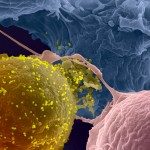Link to Pubmed [PMID] – 31547827
Link to DOI – 32510.1186/s12936-019-2950-4
Malar J 2019 Sep; 18(1): 325
Activation of hypnozoites of vivax malaria causes multiple clinical relapses, which contribute to the Plasmodium vivax burden and continuing transmission. Artemisinin-based combination therapy (ACT) is effective against blood-stage P. vivax but requires co-administration with primaquine to achieve radical cure. The therapeutic efficacy of primaquine depends on the generation of a therapeutically active metabolite via cytochrome P450 2D6 (CYP2D6). Impaired CYP2D6 metabolism has been associated with primaquine treatment failure. This study investigated the association between impaired CYP2D6 genotypes, drug-exposure to the long-acting ACT component (schizonticidal drugs) and tolerance and efficacy.Adult patients with acute vivax malaria were enrolled in a recently completed trial and treated with artesunate-mefloquine, chloroquine or artemether-lumefantrine. All received concomitant primaquine (0.5 mg/kg/day for 7-9 days). The association between efficacy and safety and drug exposure was explored using area-under-the-curve (AUC) and half-life (t1/2) estimates obtained by non-compartmental analysis of the long half-life drugs. Parasite recurrences by day 63 were categorized as related relapses or re-infections/unrelated hypnozoite activation by genotyping three microsatellite loci and two polymorphic loci of merozoite surface antigen-1. The CYP2D6 genotype was identified with Taqman assays by real-time PCR to 9 polymorphisms (8 SNPs and one deletion). Impaired CYP2D6 activity was inferred using the Activity Score System.Most recurrences in the ASMQ (67%), CQ (80%) and AL (85%) groups were considered related relapses. Eight of nine (88.9%) of the patients with impaired CYP2D6 activity relapsed with related parasite compared to 18/25 (72%) with normal activity (RR = 1.23, 0.88; 1.72, p = 0.40). There were no associations between the measured PK parameters and recurrence. Patients with longer chloroquine half-lives had more pruritus (RR = 1.09, 1.03; 1.14, p = 0.001). Higher CQ AUCs were associated with reduced falls in haemoglobin by day 14 (Coef – 0.02, – 0.005; – 0.03, p = 0.01). All regimens were well tolerated.Genotyping of P. vivax showed that activation of related (homologous) hypnozoites was the most frequent cause of recurrence. The high proportion of the impaired CYP2D6 activity among patients with recurrent infections suggests that slow primaquine metabolism might influence related relapse rates in Brazil among patients receiving primaquine for radical cure, although confirmatory studies are needed. There was no association between drug exposure of the long-acting ACT component (schizonticidal drugs) and risk of related relapse. ACT was well tolerated. These results provide further re-assurance about the safety and efficacy of ACT when combined with short course primaquine to treat uncomplicated malaria vivax in Brazil. Trial registration RBR-79s56s ( http://www.ensaiosclinicos.gov.br/rg/RBR-79s56s/ ).


